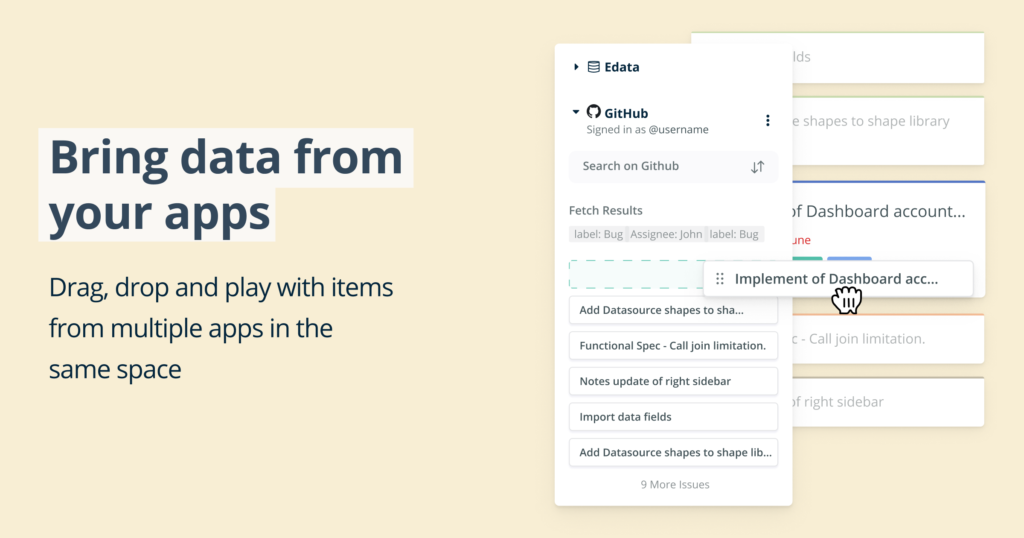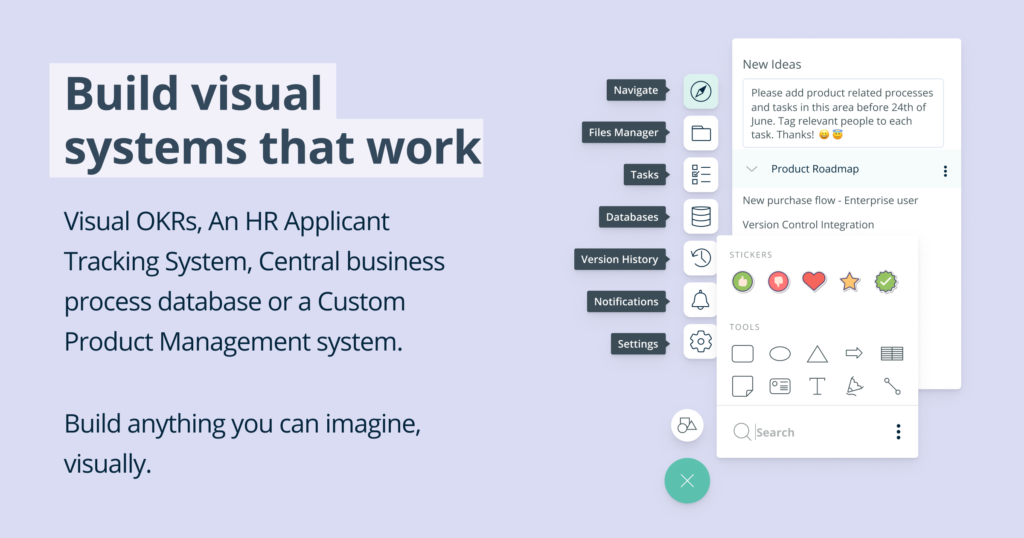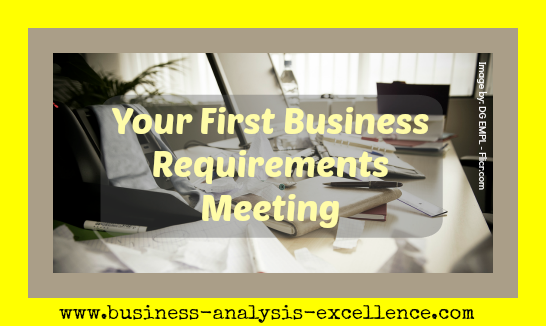YOUR FIRST BUSINESS REQUIREMENTS MEETING | 8 STEPS WITH EXAMPLE QUESTIONS
This blog article outlines some example questions to use during your first business requirements meeting with a suggested conversation flow you can include in your first business requirements meeting interview with a stakeholder. Use these example steps and business requirements questions as an ideas generator and not as the final script for your first business requirements meeting.
STEP 1: Introduction and Rapport
Always start your business requirements meeting on a positive note by asking your interviewee something that will make them feel good. Examples: pay a compliment to them, their team, and the department OR say something positive about the day. You also say anything that shows them you would like to build rapport with them in a very friendly and light-hearted way. Consider some of these non-verbal communication tips when approaching a new stakeholder for the first time too.
 STEP 2: Kick off the BUSINESS Requirements Meeting
STEP 2: Kick off the BUSINESS Requirements Meeting
Start your Business Requirements Meeting / Interview introduction. Make sure to include all of the following:
- Who you are – as the business analyst, describe your role in the organisation and your role on the project.
- Why you are there today?
- What the purpose of your visit is with this stakeholder and what you would like to achieve (high level)
Ask permission from them for you to ask them some questions about what they do.
- Example: Would it be OK with you if we ask you some questions about your group’s role in the organisation and what you would like the new system to provide?
Establish their prior knowledge of your project.
Then before you start with your business requirements gathering questions, you ask them whether you can provide them with some background on your project. Remember to include the following details: Who is the sponsor of the project, which stage is the project at, what is the timeframe and budget for the project and what are the key problem(s) this project is addressing.
- Example: Would you like me/us to provide you with a quick project overview or status update?
Then you ask them whether they have any questions for you before you start asking them questions.
- Example: Do you have any questions you would like to ask me/us before we start with our questions?
STEP 3: Current state Context questions
One of the first questions that you would like to ask your stakeholder during the business requirements meeting is whether they are able to provide you a high level overview of their Business Area. This will give you valuable background information and context of the business area that you are currently analysing.
- Example: Can you please provide me with an overview of what your department’s key functions or processes are you perform?
Tip: It is always good to do your homework and gain some level of understanding of what a particular stakeholder’s role is and what the key reasons are for their involvement. If you are able to do this, you can either lead in with your understanding of what they do and ask them to elaborate or correct your understanding.
STEP 4: CURRENT STATE BUSINESS PROCESS SPECIFICS
During your Business Requirements Meeting you have now reach the point where it is important for you to get more specific about the current state business processes. This will assist you in identifying further detail of how the stakeholder’s current business processes and functions work and help you with understanding the business process context of where your project will be addressing some of their main problem areas.
- Can you perhaps tell me/us more about [process XYZ]
(repeat these questions for all the key processes which are relevant to your project)
 Here are some example questions to use in this context:
Here are some example questions to use in this context:
- What is the purpose of this process?
- What triggers this process to start?
- Who is responsible to perform this process?
- How does this process work today?
- What is the end result or output of this process?
- Is there a system that supports this process today?
- If there is a system, are you able to show us how this system works?
- If there is a system, are you able to provide us with some screen shots from this system?
- If there is a system, are you able to refer us to where we can find the user guide for this system?
- Why do you need this process? What business objective does this process satisfy? (Ask this only if this is not obvious).
Repeat back and confirm with the stakeholder what your understanding is of what their key business processes are.
STEP 5: IDENTIFY PROBLEMS / OPPORTUNITIES FOR IMPROVEMENT
You will find that most stakeholders would be very forthcoming with areas that require improvement and where the main problems are. They will most likely have started to weave this information into some of their responses during Step 4 and you should try and steer them back to only focus on the main processes during that step. You can tell the stakeholder that during the this step (Step 5) of the business requirements meeting you will delve into detail around areas of improvement and the problems they are experiencing.
You could ask questions like these…
- Which areas of this process can be improved?
(Depending on the situation, ensure you ask about all areas where there are problems or opportunity to improve.)
- Why this is a problem area?
- What do you believe will help address this problem?
- What else do think can help address this problem?
- Do you currently have any existing operational reports which help you manage this team?
If yes:
- Are you able to tell us about your most important reports?
- Which systems produce your reports for you?
- How often to you receive these reports?
- Are you able to share some examples of these reports with me/us?
If no,
- Tell us about some of your reporting requirements. What would you really like to see produced as a report? Why?
- Discuss the content, frequency, audience and layout of the report at a high level.
Repeat back and confirm to the stakeholder what your understanding is of what they see as their key problems and which areas they would like to see improved.
STEP 6: FUTURE STATE QUESTIONS
Finally, now that you have an understanding of the current state business context and the main business opportunities and areas that require improvement you provide the stakeholder the opportunity to give their ideas and solutions for how best to solve for their business needs and problems. It is important during the business requirements meeting to provide this opportunity to the stakeholder because not only have they probably spent a lot more time thinking about these business problems and therefore can provide valuable input into a proposed solution discussion but they need to feel engaged and part of the solution. It is in reality often too early in the project to start exploring the solution (or the “how”) with the stakeholder (especially during the first business requirements interview) but see this as a technique to make the stakeholder feel involved with the solution even if you are not really ready to discuss the solution in detail yet. Perhaps just make sure during your introduction and when you get to this Step that you tell the stakeholder that although you would love to understand their initial views on how we can solve for the business needs and problems during this first business requirements meeting, they can expect to hear from you in future business requirements meetings to really delve into a detailed solution discussion with them.
You could ask questions like these…
- If you were able to provide me with your top 3 business requirements for this project, what would they be?
- Let’s drill down on each of these 3 requirements you have mentioned (repeat these questions for all three requirements):
- Why is this requirement important to your business function / group / team?
- What will this requirement enable your team to do differently or better?
Apart from these top 3 requirements, which other “wish list” items / business requirements would you like to see us include in the scope of this project?
- Why is this requirement important to your business function / group / team?
- What will this requirement enable your team to do differently or better?
Repeat back to the stakeholder what your understanding is of what they would like to see included as key requirements.
STEP 7: CLOSE THE MEETING
You must of course close your business requirements meeting with a summary of the discussion points and key actions that you may agreed to.
- Summarise the key points made during the meeting.
- Review each action item you have agreed from both sides. Stipulate the action item, the responsible person and the due date.
- Conclude by providing a huge thank you for the stakeholder’s time and openness in the meeting.
- Ask the stakeholder whether you are able to come back to them if you have any further questions.
- Agree to send the stakeholder the notes of the meeting with the agreed actions.
Remind your stakeholder of your next steps and what they can expect to hear or see coming from the project (if this is relevant).
STEP 8: AFTER THE BUSINESS REQUIREMENTS MEETING
 Send a ‘thank you’ email to your stakeholder, thanking them for their time and contribution to the definition of the requirements. Reconfirm the next steps of the project in relation to the requirements gathering exercise.
Send a ‘thank you’ email to your stakeholder, thanking them for their time and contribution to the definition of the requirements. Reconfirm the next steps of the project in relation to the requirements gathering exercise.
Tip:
If it is appropriate, in your thank you email – copy in the project manager and the stakeholder’s manager when you thank them.
In conclusion
This first business requirements meeting example outline with questions should be adapted to your specific environment and situation to be effective. This article is merely trying to give you some ideas with the basic structure of a typical first business requirements meeting and you should put in some preparation work to make it work for you! Best of luck with your first business requirements meeting and remember to use your stakeholder relationship skills to build a strong rapport with each stakeholder from this very first business requirements meeting.




